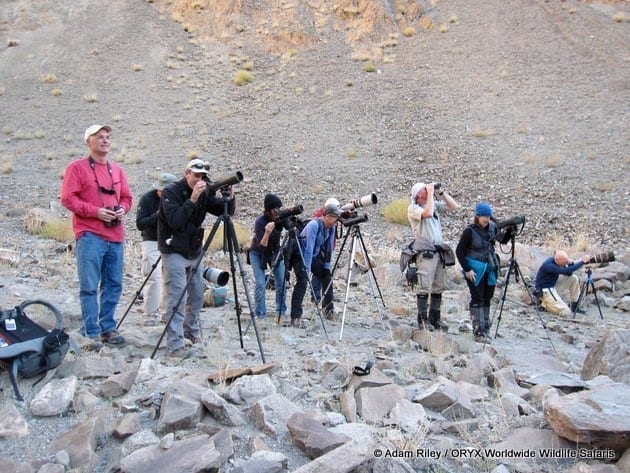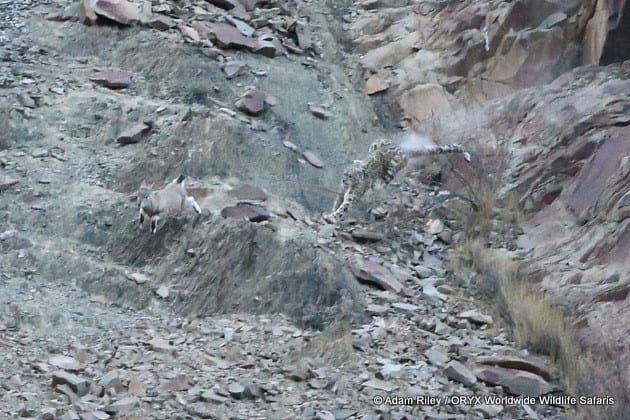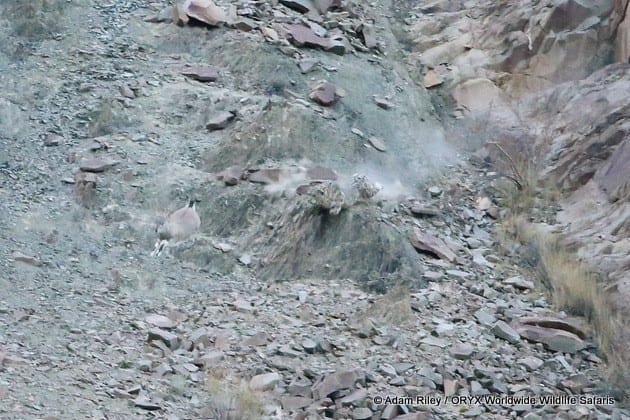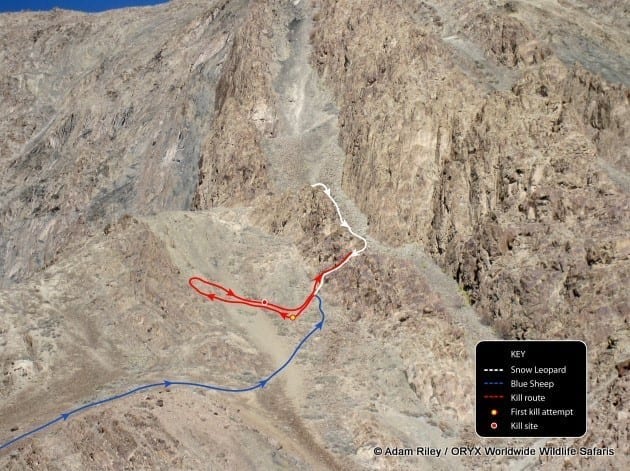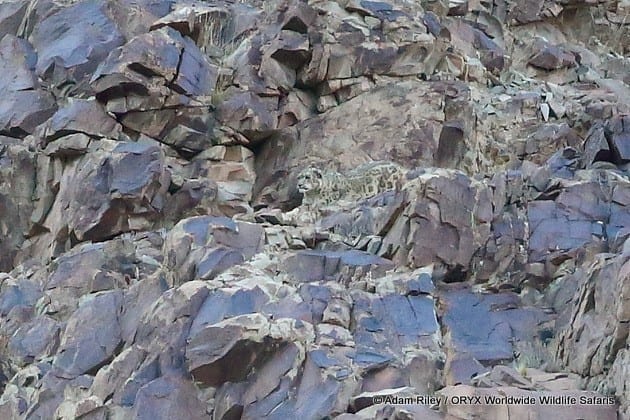
It was our third day in high elevation Hemis National Park, we had awakened before dawn and chugged down a mug of life-giving coffee before ascending a few hundred yards to a knoll above our tented camp in the Rhumbak Valley.
Our group watching the first Snow Leopard from a knoll above our camp in Hemis National Park
At this very spot, on our first afternoon in the park, and within half an hour of officially beginning our Snow Leopard search, our expert local spotter had exclaimed “Shan!!” – the Ladakhi name for Snow Leopard. After a few tense moments and some mild panic, we had all trained our telescopes on a Snow Leopard stalking across a far mountain slope. The distance was extreme, estimated at 2.5-3km, even the cat’s spots were hard to discern, yet we spent an enthralling hour and a half watching it sunning itself on a rock, then rolling like a tabby in loose gravel before setting off, at a remarkably rapid pace, across the mountain slope until it disappeared above a cliff face. Moments later it came barreling down the cliff in a chase, scattering a herd of Blue Sheep in all directions, however it didn’t seem to reach striking distance of any of them. It then disappeared over the mountain ridge, seemingly in disgust! “High fives” were shared all round, we were elated! We had 9 days in the mountains and by the first day we had already actually clapped eyes on this, the Gray Ghost of the Himalayas, albeit distantly. Seeing a wild Snow Leopard is every wildlife enthusiast’s dream, probably the ultimate and most elusive wildlife experience on the planet. This Holy Grail of sightings was until quite recently, virtually impossible, requiring months of extreme endurance for even the slimmest glimmer of hope. Peter Matthiessen’s famous book Snow Leopard describes such an attempt that proved ultimately unsuccessful in his primary goal of glimpsing a Snow Leopard.
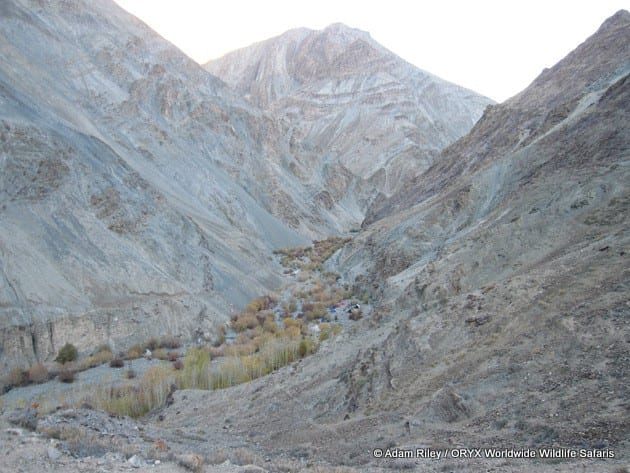
Knowing this, we were certainly far from disappointed by our experience but we of course all dreamed of a closer view. So the next day we trekked to the Tarbung Valley, lying below our camp. It was on the upper slopes of this valley where our distant Snow Leopard had been observed. By the end of the day our eyes were stinging with the effort of incessantly scanning the slopes surrounding us for another view of this cryptic feline. I hadn’t imagined that there would literally be millions of locations within view at any time where a Snow Leopard could be hiding! By sunset we felt that we were faced with a near impossible task and were grateful for the extreme luck to have obtained our first sighting! However, we were somewhat encouraged by spotting at least 10 herds of Blue Sheep (locally known as Bharal) on the slopes around this lower valley. These sturdy mountain sheep are the preferred diet of the Snow Leopard in this part of its range and the high density of prey was a good indication that a predator should be around!
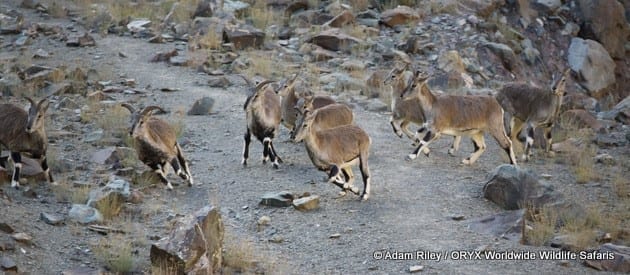
Our guide explained that camera traps scattered at strategic sites in the three valleys around our camp had revealed that there were no less than 11 resident Snow Leopards in the immediate vicinity! An astounding density for a large predator, especially in such a cold, desert-like environment. Furthermore, the total population in Hemis National Park is estimated at 50-60 individuals, making the park an important genetic reservoir for this species which is classified on the IUCN’s Red Data List as Endangered. In case we had any doubts, our guide led us to one of these camera traps where he hauled out the camera and as we flicked through the past few weeks’ images, we were amazed to see close-up shots of Snow Leopard after Snow Leopard; males, females, cubs, taken both at night and day!
Day three had dawned bright and sunny once again. In fact these days in late October were just stunning, and despite being at 3,900m in elevation, the conditions necessitated no more than a t-shirt! However as soon as the sun disappeared behind the mountains, a remarkable phenomenon occurred; the mercury literally plummeted more than 20 degrees centigrade to below zero over a short time. We opted for a pre-breakfast scan at the knoll above camp from where we had lucked into our first sighting. This time it was our assistant Snow Leopard spotter who uttered the magical word, and after a scramble we were again all watching a much closer Snow Leopard in the Tarbung Valley. The cat actually appeared almost golden in the early morning light and this time we could admire its magnificent thick, blotched pelt, extremely long tail and large head. Snow Leopards are the subject of recent taxonomic debate, sometimes being placed in their own genus Uncia (from their earliest Western name Ounce, an ancient name first given to the Eurasian Lynx; which also occurs in Hemis National Park). However most recent research places them amongst the Panthera. This is the genus of the typical large cats including Lion, Leopard, Jaguar and Tiger. In fact genetic evidence indicates that the Snow Leopard’s closest living relative is the Tiger. Our Snow Leopard sat, quite Cheetah-like, before stalking off and once again rolling in the gravel, apparently an indication of the desire to mask its scent before a hunt. We realized that we could place ourselves much closer to our dream target if we hiked down into the valley where we had spent the previous day, so we left one of our spotters on the knoll with a radio and we descended with bated breath, by-passing camp and breakfast en route!
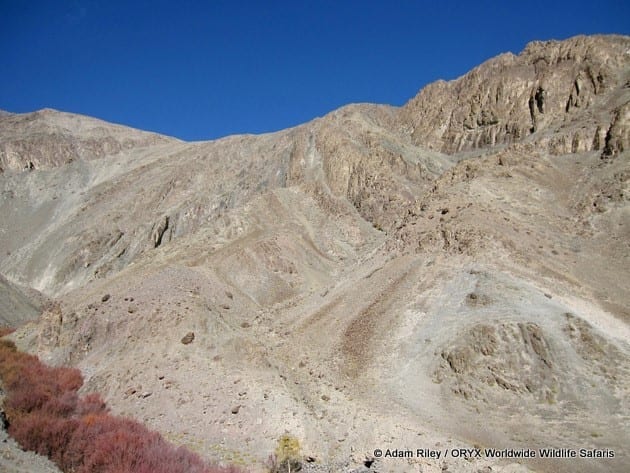
Half an hour later we were on the slope opposite to where we had seen our Snow Leopard and with directions from our spotter we managed to relocate the cat. It was barely visible at the top of an outcrop about 300m away, cautiously peering over the rocks at us. We settled down and trained our telescopes, cameras and binoculars on the far slope and slowly but surely, our leopard gained confidence until it lifted its whole head and stared at us. After an hour, a pleasant surprise awaited us when our camp staff arrived with hot breakfast and coffee in tow and served us a delicious meal in situ as we marveled at the Snow Leopard! Hard to believe this was real! As the sun rose and the day heated up, our cat dozed off, all we could see was a paw and the top of its head. Lunchtime rolled around and once again we were treated to another hot meal brought up from camp.
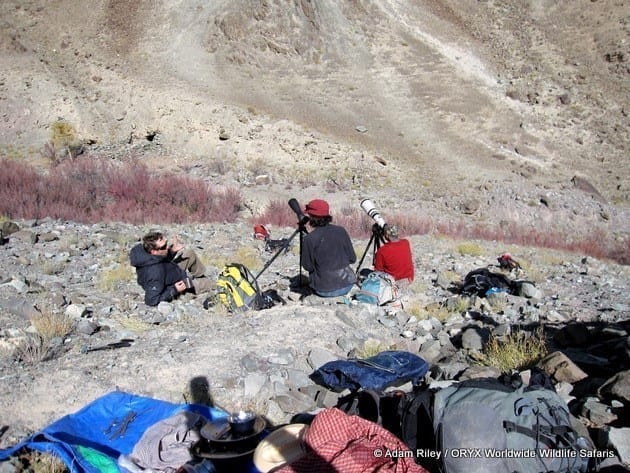
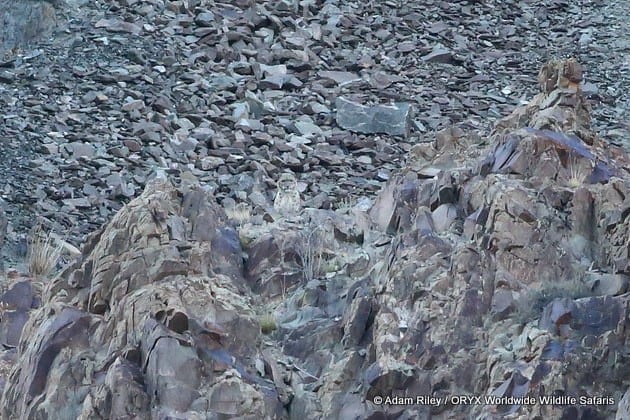
As the shadows lengthened, a herd of ten Blue Sheep made an appearance on the scene. They slowed grazed their way up from the stream cutting through the valley, heading in the general direction of the rocky outcrop in which our Snow Leopard was resting. Closer and closer they approached and our adrenalin levels began to rise, but then the lead sheep changed direction and started moving back down the hill. Seven in total descended but two adults and a juvenile kept moving towards the danger zone…..
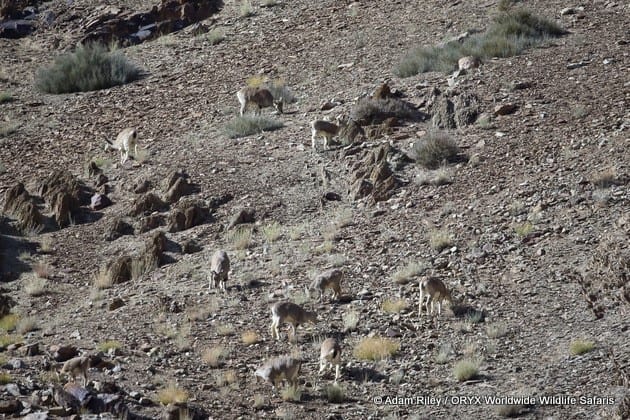
After an hour the sun dipped over the horizon and the temperatures started to plummet. The three upper sheep stopped grazing and lay down, seemingly bedding down for the night, and we guessed that the show was over. In fact some of our group decided to head back to camp. However after another quarter of an hour these three sheep started grazing again and continued making their way to the lusher grasses growing along the base of the outcrop in which our Snow Leopard was still snoozing. Suddenly the Snow Leopard detected the presence of its prey and sat up on its haunches for the first time since we had relocated it. It began to bob its head from side to side, a clear feline sign of measuring distance and perspective in planning an attack. We could not believe our fortune, could we really be treated to a Snow Leopard hunt – this was beyond our wildest dreams? Then the leopard was moving and it headed along the top of the outcrop, disappearing on the hidden slope opposite to where the sheep were grazing.

Two minutes later it appeared half way down the outcrop and slightly above the Blue Sheep. First it sat up trying to relocate its prey and once locked on, the cat slunk low and crept into a fault line that ran across the outcrop towards the sheep. Half way across the rocks, it sunk into a hollow, just the top of its head visible as it kept a careful watch. The two adult sheep now began moving away from the attack zone, did they have an instinct that danger was near, or did they know from experience not to dally near rocks where leopards might lie in wait?
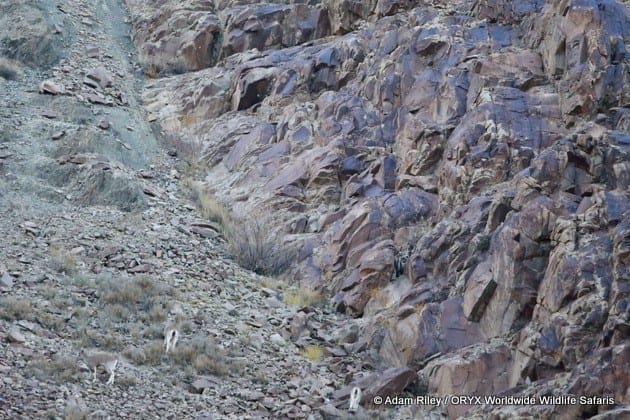
However the young sheep carried on oblivious heading higher up the slope along the edge of the outcrop, and closer and closer to the hidden Snow Leopard. By this stage we were all at our wits end and shaking with excitement, was the Snow Leopard going to charge, why was it taking soooooo long? My shoulders were aching with the effort of holding my camera ready for the pounce.
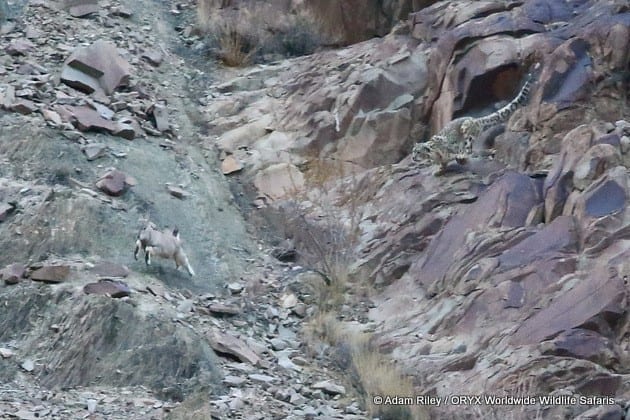
And finally in a blur, everything happened. The Snow Leopard leapt from its cover, bounding across the rocks in great leaps towards the young Blue Sheep. All three sheep took to flight, creating dust trails in their wake. The speed at which the Snow Leopard closed ground on the young sheep was remarkable as it barreled off the rocky outcrop to open ground, clearing a large rock en route.
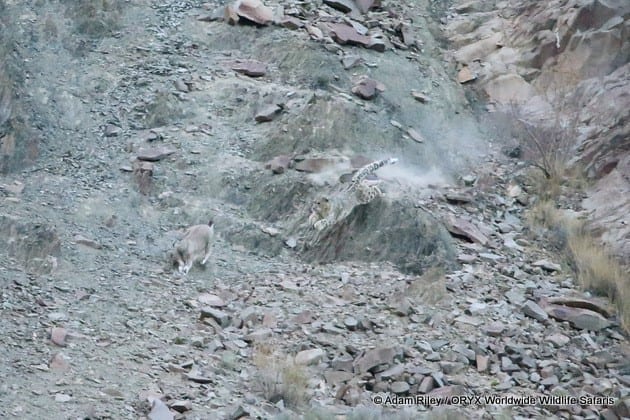
Within seconds the Snow Leopard was on the hapless sheep. After careful scrutiny of images, it seems that the Blue Sheep lost its footing as it tried to escape but in the process it kicked up a load of gravel and dust, right into the Snow Leopard’s face, temporarily blinding the cat. This gave the sheep a vital break and it was able to pull away from the leopard which kept at its heels but was several critical paces behind.
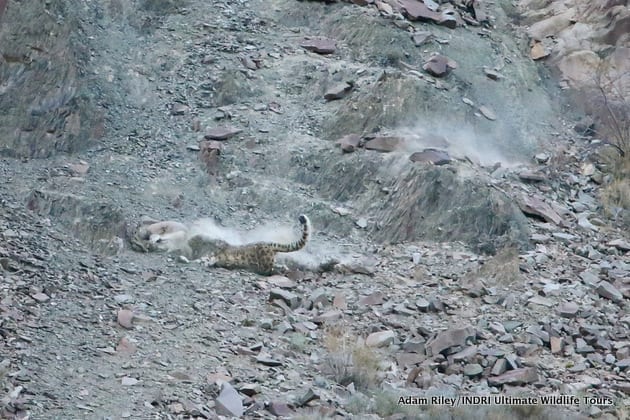
The two adult sheep had gone their separate ways, one heading downhill away from the danger and the other, possibly the younger sheep’s mother, scrambling up a steep slope. At this point, our young sheep made a tactical error and instead of fleeing downslope, it tried to follow the upper sheep.
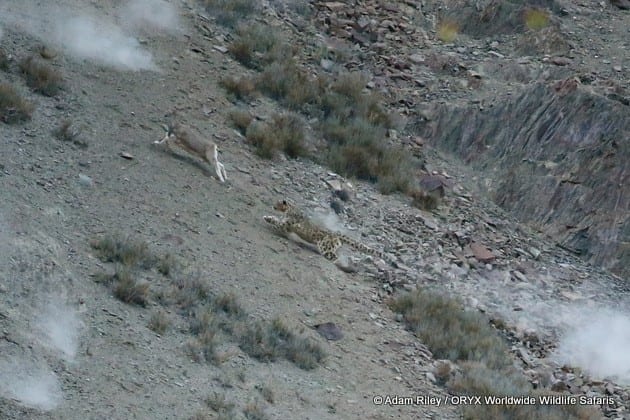
The slope became incredibly steep, almost vertical, and this gave the Snow Leopard its chance to gain ground on its shorter legged target.
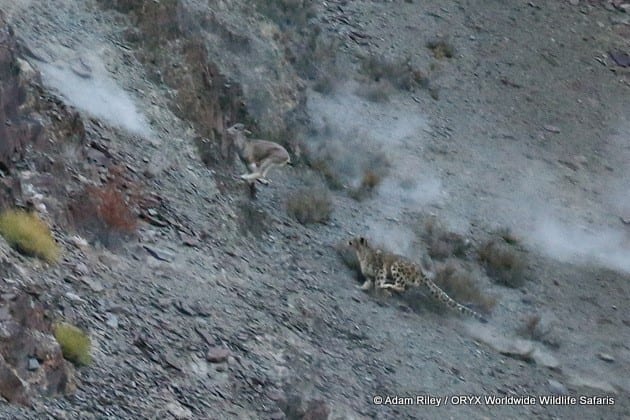
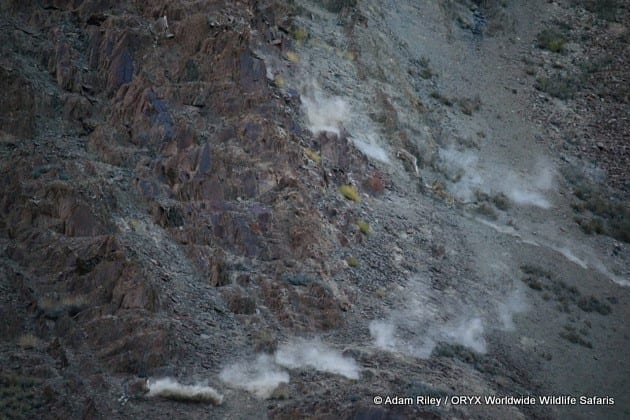
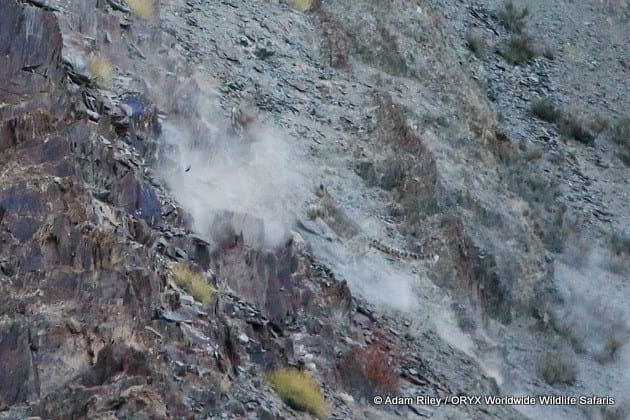
Finally, the young sheep realized the leopard was almost upon it and bravely pulled a u-turn, heading back down the slope in the direction from which it had come. Snow Leopards have extremely long tails, up to a meter in length and besides storing fat, the tail is utilized as a ‘scarf’ in the winter. This tail is also a valuable rudder and balancing device, thus the Snow Leopard was easily able to perform its own abrupt u-turn and track the sheep back down the slope.
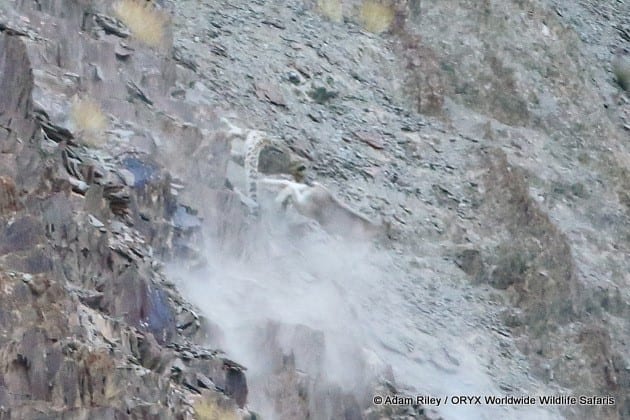
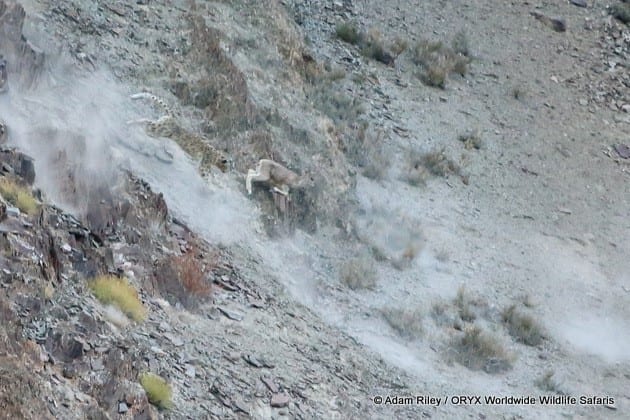
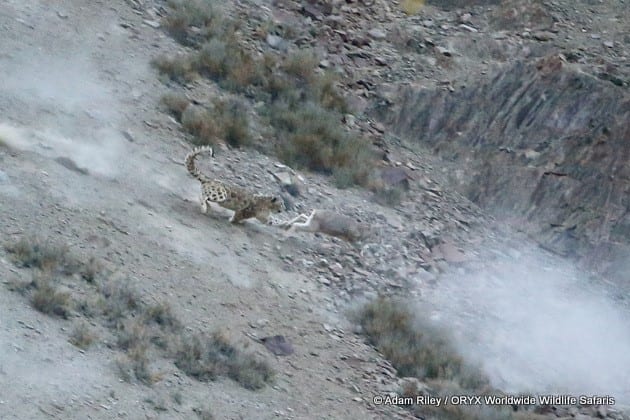
Extending a paw, the Snow Leopard seemed to ankle-tap the sheep and as it rolled, the cat leapt onto sheep and immediately latched onto its throat. This take at such high speed and on a steep slope meant gravity took its affect and the cat and sheep tumbled over and over each other until the Snow Leopard took control of the situation. The Snow Leopards’ thick pelts have long been highly sought-after artifacts by the people who share its Central Asian range, providing amazing insulation in the cold, but another reason their pelts are so thick must be to protect the leopard when it takes rough tumbles across its rugged, rocky environment.
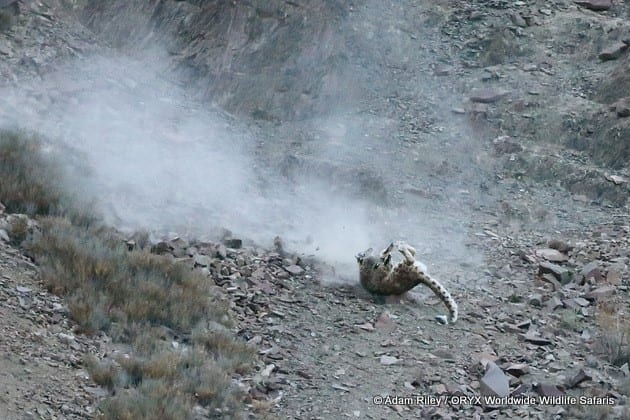
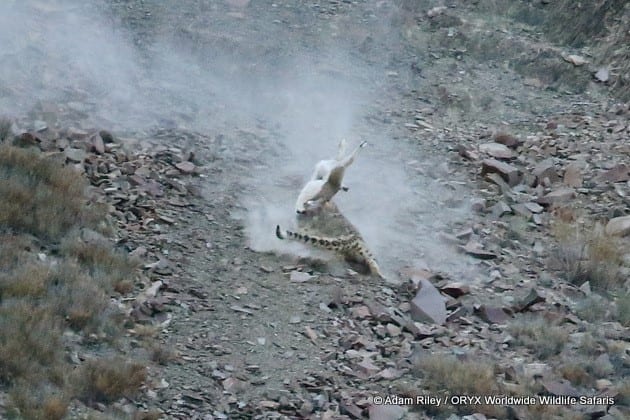
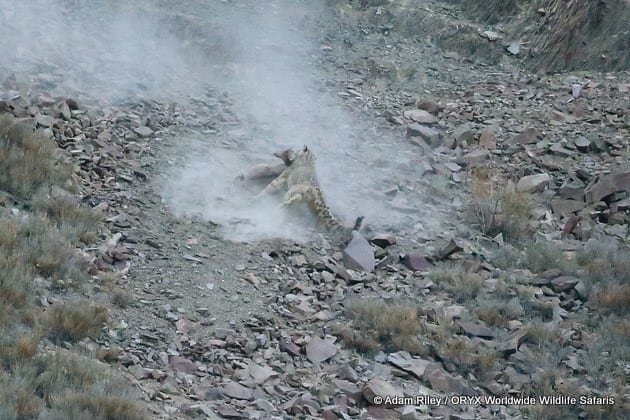
For at least 3 minutes the Snow Leopard lay alongside the young sheep, firmly attached to its throat as it suffocated its prey, the Blue Sheep feebly kicking its hind legs intermittently.
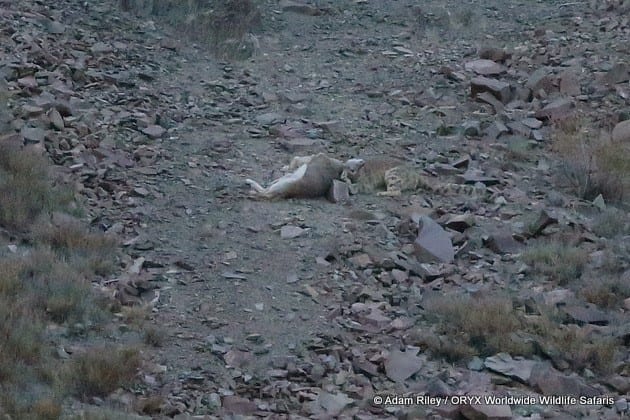
Only when it was certain the sheep was dead did our predator finally release its fatal grip and rest alongside its upcoming meal for several minutes, catching its breath after such an extreme effort. For the first time in minutes, the Snow Leopard became aware of us again, ensuring we had not moved and were posing no threat on the opposite slope.
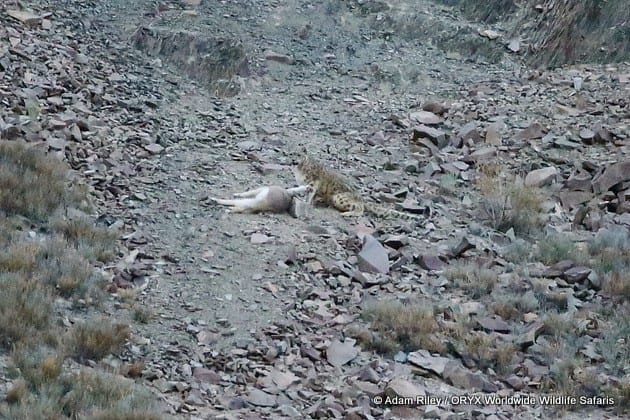
Finally the Snow Leopard picked up the Blue Sheep and dragged it across the open area, pretty much following the route of the chase, back to the fault line in the rocks and finally over the rocky outcrop and out of our view where presumably it feasted on its well-deserved meal!
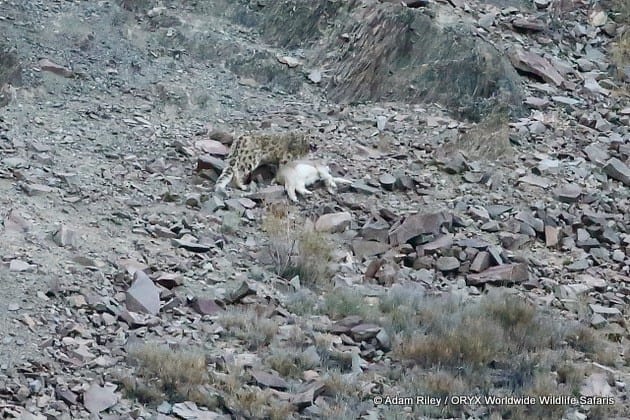
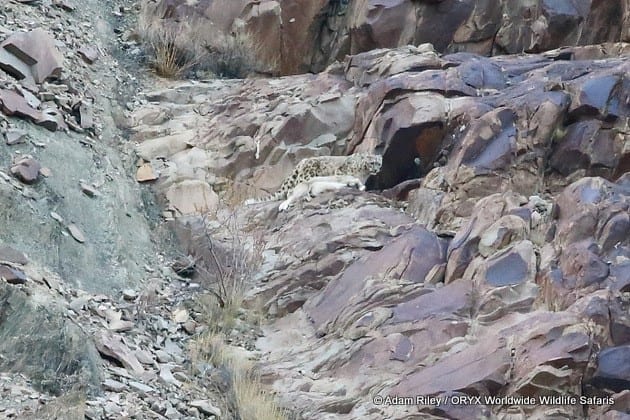
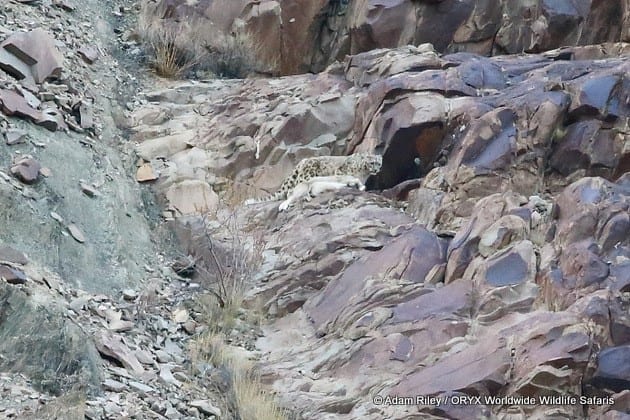
By this time the light was fading fast and we arrived back in camp half an hour later in the pitch dark, still not quite believing what had unfolded before our eyes!
This was truly an incredible encounter we had been so, so fortunate to witness; a full Snow Leopard hunt from beginning to end including the take and kill. Our Snow Leopard spotter had been working in Hemis for 16 years and he had never seen this happen before nor knew anyone else who had been as fortunate as us. Film crews and professional photographers have spent months and sometimes even years following Snow Leopards and although several thrilling hunts have been captured, as far as we are aware, no successful hunt has ever been photographed! I am exhilarated therefore to be able to share my images and story of this hunt with you.
The scene of the Snow Leopard hunt in the Tarbung Valley – the white line begins at the point where the Snow Leopard spent the day and tracks the route of the leopard’s stalk along the back of the rocky outcrop and then across the fault line in the rocks. The blue line follows the route of the Blue Sheep as they grazed towards the rocky outcrop. The red line follows the chase with the yellow dot indicating the first failed attack and the red dot being the final kill position
For anyone wishing for the opportunity to witness such an incredible event, ORYX – Worldwide Wildlife Safaris (www.oryxwildlifesafaris.com) offer Snow Leopard expeditions annually in October and February, combined with a Royal Bengal Tiger and Indian One-horned Rhinoceros extension. They also arrange and guide other wildlife tours globally to the world’s last remaining wildernesses in search of iconic wildlife.
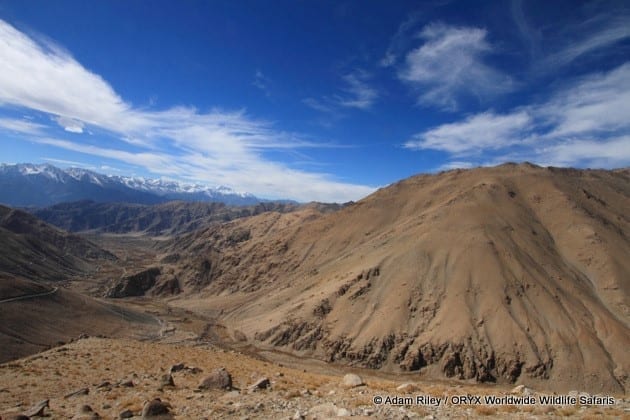
The 4,400 square kilometre Hemis National Park is the largest park in the whole of South Asia. It is accessed through the high altitude (3,500m) city of Leh, capital of Ladakh in Jammu-Kashmir State, north west India. Regular flights operate from New Delhi offering phenomenal views flying over the Great Himalayan Range. Ladakh, also known as Little Tibet due to the local influx of Tibetans after the Chinese take-over of Tibet, is situated on the border with Tibet but several hundred kilometers east of the volatile and disputed Pakistani Kashmir boundary. Leh and its surrounds are well worth exploring, in fact essential since its necessary for most people to acclimatize here for at least one full day before beginning their Snow Leopard expedition in nearby Hemis National Park.
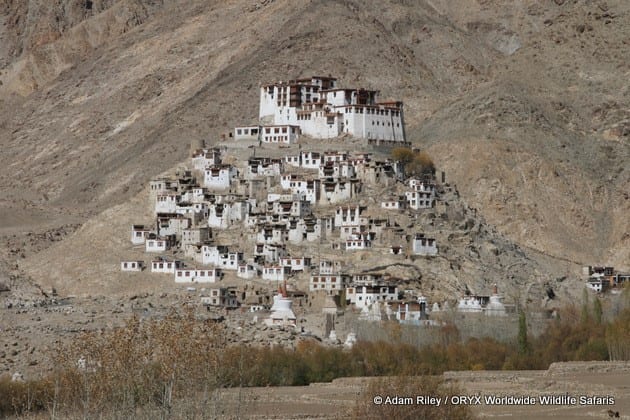
Several impressive temples and monasteries are dotted around Leh and the birding can be excellent with species such as Ibisbill, Solitary Snipe and Mountain Leaf Warbler to name but a few. Access to Hemis National Park is via a short drive to Zingchen and this scenic route offers the best chance for locating the long legged and large bossed Ladakh Urial also known as Red Sheep. The road comes to an end near the boundary of Hemis and from here it’s an easy walk of less than an hour to the base camp in the Rumbak Valley (3,900m). Within the vicinity of camp and its surrounding valleys, 11 Snow Leopard are resident. For those with additional time, it is worth hiking deeper into the park to Kanda La pass (4,900m) and here Woolly Hares are much commoner as are their main predator, the Eurasian Lynx. The huge Argali, another species of wild sheep, also occur here. Wolves can be encountered anywhere in the park. Birding opportunities are limited with fairly low diversity at this elevation but typical species include Lammergeier, Golden Eagle, Himalayan Snowcock, both species of chough, White-winged Redstart, Brown Accentor and Fire-fronted Serin.
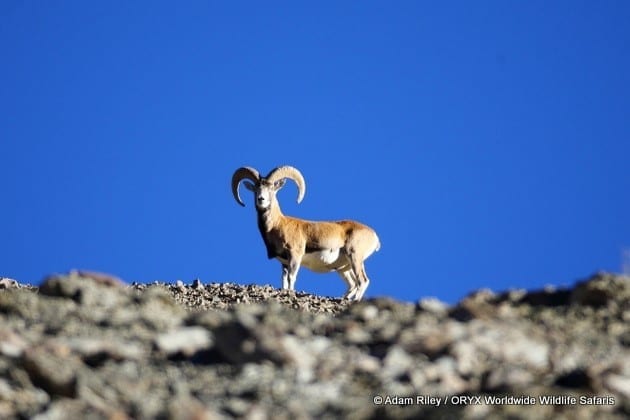
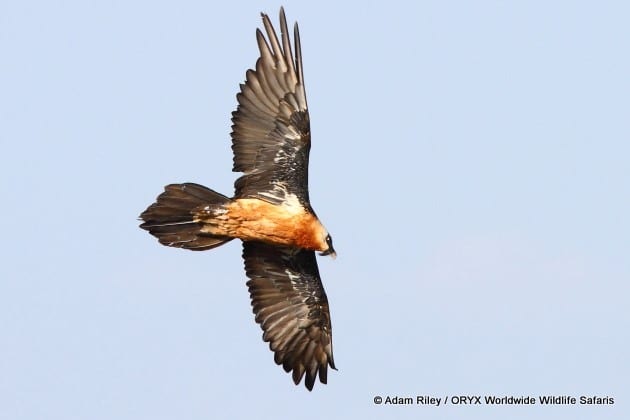
All text and photographs are by the author and protected by copyright.
